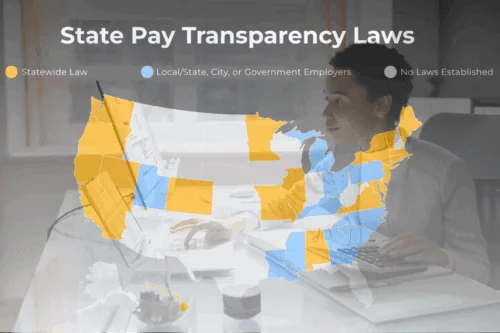Welcome to our guide on right to work laws, designed specifically for entry-level job seekers looking to navigate the complex landscape of employment regulations in the U.S. Whether you are just entering the job market or considering a career move, understanding these laws is crucial for making informed decisions about your employment opportunities.
Why This Guide Is Important
Right to work laws can significantly influence your work atmosphere, relationship with unions, and overall job satisfaction. These laws vary by state, and knowing whether your state is a right to work state can affect your approach to job hunting and your rights as an employee. This guide provides clear, easy-to-understand insights into how these laws operate, their impact on the workforce, and what you need to know to protect and advance your career.
We’ll explore everything from the basic definitions of right to work laws, their implications for employees and unions, to the controversies and legal challenges surrounding them. With each section, you’ll gain the necessary knowledge to approach your job search and career development confidently and wisely.
Prepare to equip yourself with the tools needed to understand and navigate the world of work under these laws. Let’s dive into the details.
Understanding Right to Work Laws
Right to work laws are significant pieces of legislation that affect the workforce and labor unions across various states in the U.S. Essentially, these laws determine whether employees can be required to join or pay dues to a union as a condition of their employment.
Key Features of Right to Work Laws
These laws share several foundational features:
- Employee Freedom: They allow employees to join or support a union.
- Prohibition of Mandatory Union Membership: Employers cannot mandate union membership for employment.
- Influence on Union Dues: Employees are not required to pay union dues if they choose not to join the union.
States with Right to Work Laws
Currently, twenty-seven U.S. states have enacted right to work laws. These laws are primarily found in the southeastern part of the U.S. but have also been adopted in other regions, impacting a diverse range of economic sectors and labor markets. To learn more about these states, visit the National Right to Work Foundation resource.
Legal Basis
The legal basis for right to work laws originates from the Taft-Hartley Act of 1947. This federal law restricted labor union activities and permitted states to decide whether they wanted to implement them.
When considering job changes or career paths, it’s useful to be aware if you’re entering a right to work state. Navigating these regulations can directly affect your work conditions and relationships. For example, individuals in states that are not right to work might experience different job negotiation strategies, which could impact discussions of job offer strategies.
Knowing your rights and obligations concerning union participation can be crucial during interviews and job discussions. Preparing for Interview Questions in such contexts is equally essential. Next, we will explore these laws’ varying effects on employees and unions to provide a fuller picture of their implications.
The Impact of Right to Work Laws on Employees and Unions
Right to work laws significantly shape the labor landscape, influencing employees and unions in various ways. These impacts can be broad and deeply felt, altering everything from workplace dynamics to the financial stability of unions.
Effects on Employees
Employees in states with right to work laws experience a unique set of conditions:
- Job Security and Wages: Research suggests mixed outcomes on wages and job security. Some studies indicate slight wage decreases and reduced job security in right to work states.
- Employment Choices: Employees may find they have more employment options available, as employers in right to work states can offer a variety of arrangements free from union constraints.
Effects on Unions
Unions in right to work states face their challenges:
- Membership Numbers: Typically, unions see a reduced membership since joining is not compulsory.
- Funding and Resources: Lower membership means less funding, which can impact the union’s ability to negotiate effectively on behalf of workers.
These dynamics are not just theoretical but are observed and studied by labor economics experts. For more detailed analyses, academic resources like those found in the U.S. Bureau of Labor Statistics offer deeper insights into the effects of right to work laws. In addition, right to work laws may also influence union activities and their negotiating power, which could lead to different outcomes regarding worker rights and employer relationships. To understand more about how these laws interact with union security agreements, visit the segment on Opportunities for Inclusion.
Right to Work vs. Union Security Agreements
Understanding the nuances between right to work laws and union security agreements is essential for comprehending labor dynamics in the U.S.
What are Union Security Agreements?
Union security agreements require workers to join the union or pay union dues as a condition of employment. These agreements ensure that all workers contribute to the cost of union representation.
Comparison with Right to Work Laws
On the other hand, right to work laws prohibit these agreements, advocating that employment should not be contingent upon union membership or dues payments:
- Freedom of Choice: These laws allow individuals to choose whether to join or support a union.
- Union Influence: They tend to reduce unions’ power and financial resources.
Impact on Workers and Employers
These differences have tangible effects on both workers and employers:
- Workers in states with union security agreements often enjoy higher wages and better benefits, supported by solid union negotiation.
- Employers in right to work states appreciate more flexibility in managing their workforce without mandatory union involvement.
This contrast highlights a fundamental divide in labor policy across the U.S., influencing decisions on both sides of the employment equation. As the economic landscape evolves, these differences play a critical role in shaping workers’ opportunities and challenges today.
Economic Effects of Right to Work Laws
The economic implications of right to work laws are complex and varied, impacting state economies and individual livelihoods.
Influence on State Economies
States with right to work laws often tout these statutes as tools for attracting businesses:
- Business Attraction: Proponents argue that these laws make states more appealing to business investments, potentially leading to job creation.
- Economic Growth: Some reports suggest a correlation between right to work laws and faster economic growth in states.
Wage Comparisons
However, the impact on wages is a subject of ongoing debate:
- Lower Wages: Critics of right to work laws point out that these states often have lower average salaries than states with union security agreements.
- Cost of Living: Supporters counter that lower living costs in these states often offset lower wages.
To view detailed statistics and ongoing studies regarding economic outcomes associated with right to work laws, resources such as the Economic Policy Institute provide extensive data and analysis. While these laws can attract businesses, they may also lead to significant worker compensation and job security shifts, affecting consumer spending and overall economic stability.
Legal Perspectives on Right to Work Laws
Right to work laws intersect significantly with legal frameworks, influencing state and federal policies.
Federal Guidelines
These laws are grounded in the Taft-Hartley Act of 1947, which allows states the discretion to enact such laws:
- Legal Framework: The Act provides a legal basis for states to decide how they manage labor relations within their borders.
- Federal vs. State Power: This autonomy showcases the balance of power between federal authority and state governance in labor issues.
Constitutional Challenges
Despite being legally backed, right to work laws often face various legal challenges:
- Court Cases: Numerous lawsuits challenge the fairness and legality of these laws, citing concerns over worker rights and union viability.
- Rulings: Decisions from these cases can significantly influence the future of right to work legislation.
Reviewing the National Labor Relations Board offers critical insights into recent legal developments related to right to work laws. Additionally, understanding how these laws compare and contrast with other labor regulations can provide a clearer picture of their impact.
Exploring State Variations in Right to Work Laws
Each state in the U.S. has its own approach to right to work laws, leading to a rich and varied labor environment nationwide.
Regional Differences
While twenty-seven states have adopted right to work laws, their impact and the specifics of how they are applied can vary significantly:
- South and Midwest: Predominantly, these regions embrace right to work laws, influenced by political and economic factors.
- Resistance in Other Regions: In contrast, states like California and New York maintain strong union protections and have resisted such laws.
Impact on Local Economies
The presence or absence of these laws influences local economies:
- Economic Incentives: States often use the existence of right to work laws as a competitive advantage to attract businesses.
- Worker Benefits: Variations in laws can lead to differences in worker benefits and protections across states.
Official state government and legal sites provide comprehensive state-level analyses of how these laws are implemented, providing updates and detailed descriptions of each state’s specifics. The diversity in application and interpretation among states highlights the complexity of employment law in the U.S., showing how localized legal environments shape broader economic and social outcomes. As these laws continue to evolve, understanding their nuances becomes crucial in navigating the American labor market.
Challenges and Controversies Surrounding Right to Work Laws
Right to work laws continuously provoke heated debates and face various challenges due to their considerable impact on labor relations and worker rights.
Debates on Worker Rights
One of the core controversies involves the balance between individual freedom and collective bargaining rights:
- Proponents argue these laws protect individual freedom by allowing workers to choose whether to join unions or pay dues.
- Opponents believe they weaken unions and, consequently, the collective bargaining power necessary to improve working conditions and wages.
Economic Disputes
Economic implications also add to the dispute:
- Supporters cite enhanced job creation and investment in right to work states.
- Critics point to statistics showing lower average wages and reduced worker benefits in these states.
Legal and Ethical Considerations
Legal challenges keep emerging, questioning the constitutionality and fairness of these laws:
- Several high-profile cases have reached national courts, reflecting widespread disagreement over these laws’ ethical implications.
- Visiting legal resources like the National Right to Work Legal Defense Foundation is essential for up-to-date legal cases and information related to these laws.
This ongoing discourse ensures that right to work laws remain a critical and evolving aspect of American labor law. With ongoing changes, both businesses and workers must stay informed about their rights and the legal landscape. As these debates continue, they shape the laws and influence public opinions and the future of the American workforce.
FAQs
Here are answers to some frequently asked questions about right to work laws, providing clarity and further insight.
What exactly does ‘right to work’ mean?
‘Right to work’ refers to U.S. state laws prohibiting union security agreements between companies and workers’ unions.
Are the laws suitable for working in the same state?
No, while the core principle remains the same, the specifics and applications can vary significantly from state to state.
Do right to work laws affect union membership?
Yes, these laws generally lead to lower union membership because they allow employees to opt out of joining a union or paying dues.
How do right to work laws impact wages?
Studies show that wages in right to work states are often lower than those in non-right to work states.
Can I be forced to join a union?
In right to work states, you cannot be compelled to join a union or pay union dues as a condition of employment.
Do these laws impact the quality of job conditions?
Opinions vary, but critics argue that weaker unions may result in poorer job conditions and fewer benefits.
Conclusion
Right to work laws play a crucial role in shaping labor relations and worker rights across the United States. While these laws offer employees the freedom not to engage with unions, they also invoke significant debates on their impact on wages, job security, and union power. Understanding these laws is vital for workers and employers alike, as they navigate the complexities of the labor market.
Empower Your Employment Decisions
Whether you’re considering a new job in a right to work state or seeking more information on how these laws might impact your current position, it’s essential to stay informed. By understanding the benefits and challenges of these laws, you can make more empowered decisions about your career and workplace rights.
Join Diversity Employment and upload your resume today! Gain access to a wealth of resources designed to help you with your diversity job search and navigate the diverse landscape of employment opportunities and challenges. By joining, you’ll connect with a supportive community that values inclusion and informed decision-making in the workplace.




